Judy Ledgerwood
Judy Ledgerwood (born 1959) is an American abstract painter and educator, who has been based in Chicago.[1][2] Her work confronts fundamental, historical and contemporary issues in abstract painting within a largely high-modernist vocabulary that she often complicates and subverts.[3][4][5] Ledgerwood stages traditionally feminine-coded elements—cosmetic and décor-related colors, references to ornamental and craft traditions—on a scale associated with so-called "heroic" abstraction; critics suggest her work enacts an upending or "domestication" of modernist male authority that opens the tradition to allusions to female sexuality, design, glamour and pop culture.[6][7][8] Critic John Yau writes, "In Ledgerwood’s paintings the viewer encounters elements of humor, instances of surprise, celebrations of female sexuality, forms of vulgar tactility, and intense and unpredictable combinations of color. There is nothing formulaic about her approach."[9] Ledgerwood has exhibited widely at galleries throughout the United States and in Europe and at institutions including the Art Institute of Chicago,[10] Museum of Contemporary Art Chicago,[11] Smart Museum of Art,[12] and Renaissance Society.[13] Her work belongs to the public art collections of the Metropolitan Museum of Art,[14] Museum of Contemporary Art, Los Angeles,[15] Art Institute of Chicago,[16] and Museum of Contemporary Art Chicago,[17] among others; a monograph, Judy Ledgerwood, was published in 2009 by Hatje Cantz.[1][18] Ledgerwood lives and works in the Chicago area with her husband, artist Tony Tasset, and teaches at Northwestern University.[19][20]
Judy Ledgerwood | |
|---|---|
| Born | 1959 Brazil, Indiana, United States |
| Nationality | American |
| Education | School of the Art Institute of Chicago, Art Academy of Cincinnati |
| Known for | Painting, Installation art, Education |
| Spouse(s) | Tony Tasset |
| Awards | National Endowment for the Arts, Louis Comfort Tiffany Foundation, Illinois Arts Council |
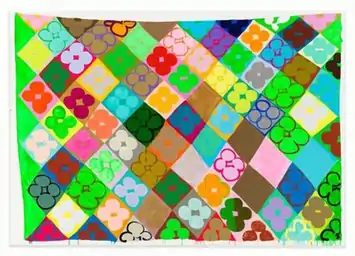
Life and career
Ledgerwood was born in 1959 in the small farming community of Brazil, Indiana and identified as an artist from an early age.[21][22][23] Her Midwest upbringing informed the sense of space and light in her early landscape-related work and her later use of craft and decorative forms relates to being from, in her words, a "family of quilters."[23][24][22] Ledgerwood attended the Art Academy of Cincinnati (BFA, 1982), where she met her future husband, artist Tony Tasset.[25] After graduating, she enrolled at the School of the Art Institute of Chicago (SAIC), attracted by that city's balance of affordability, available large studio spaces, and connection to the larger art world.[2] At SAIC, she studied under artists Christina Ramberg and Phil Hanson, among others, earning an MFA in 1984.[26]
Ledgerwood was part of a conceptually oriented group of Chicago artists that embraced theory and a global, rather than regional, view of the art world, distinguishing them from the earlier Chicago Imagists.[27][28] She began exhibiting professionally in group shows at galleries such as Randolph Street and Feature in 1987–8; solo efforts at Scott Hanson Gallery (New York, 1989) and Robbin Lockett Gallery (Chicago, 1989–92) soon followed.[29][21] In 1993, she began her teaching career at SAIC; she joined the Department of Art, Theory and Practice at Northwestern University in 1995, and was tenured in 2002.[24] She has served as the department's Director of Graduate Studies and is the Alice Welsh Skilling Professor of Art.[23][20] Ledgerwood has continued to exhibit widely, at galleries including Häusler Contemporary (Munich/Zurich, 2005–19), Tracy Williams Ltd. (New York, 2005–16), 1301PE (Los Angeles, 2002–19), Rhona Hoffman (Chicago, 2000–18), Feigen, Inc. (Chicago/New York, 1993–2000), and Barbara Davis (Houston, 2013–9).[18][21][1]
Work and reception
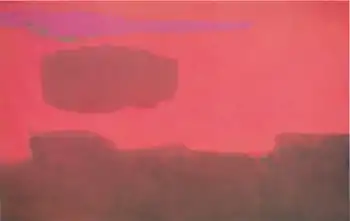
Ledgerwood emerged in the 1980s during a postmodern crisis of faith in painting's relevance, viability, patriarchal conceits, and commodification by the art market—issues her work addresses through a range of formal and feminist-critical strategies.[3][30][31] Her early work investigated gender issues encoded in 19th-century landscape painting and mid-20th-century Abstract Expressionism through formal choices informed by being female.[32][7] Her later work has shifted toward less referential, more direct abstraction focused on structure, light, color, decorative motifs, and physical presence and experience; it directly or indirectly references antecedents including Op Art, Matisse, Warhol, and the Pattern and Decoration movement.[3][6][4][33] Critics identify as central to her work: transgressive use of color as a vehicle for content and critique; imposing scale; attention to spatial relationships between picture plane and edge and surrounding physical space; freely painted, shifting motifs of patterned basic shapes; an emphasis on performative and material aspects of painting; a phenomenological embrace of tenuousness and optical effects regarding the viewing experience.[34][7][4][8][26][33]
Landscape-related abstraction (1988–1993)
Critic Kathryn Hixson described Ledgerwood's early paintings as cunningly painted "commodity object[s] of seemingly inspired, moody, atmospheric space" appropriated from the sublime traditions of Romanticism (Turner, Ryder) and color-field painting (Rothko, Newman), rather than inspired by nature.[35][30] Largely monochromatic and monumental, they featured nearly uniform oil and encaustic surfaces that hovered between enveloping abstraction and irregular fields barely suggesting landscape (e.g., Composition in Pink, Brown and Violet or Summer Fog, 1992),[36] with occasional insertions of small, flat rectangles that blurred distinctions further.[37][38][39][7] While traditional reviewers were sometimes less attuned to Ledgerwood's conceptual intent,[40][41] others identified in her articulation of differences a subversion of conventional equations of sublime with masculine, and beauty with feminine.[42][37][39][5][34] Maureen Sherlock suggested that Ledgerwood's canvasses restaged domestic, "demure and private gestures" in powerful, public form through their highly charged synthetic colors (pinks, roses, reds), which evoked female domains (cosmetics, the body, interior design), and intimate markmaking (dabs, finger-painting), which deflated the mythic power and profundity of Abstract-Expressionist gesture.[7][35][5][34] David Pagel described the work as orchestrating a "double-sided viewing" that "surreptitiously traced the power of American abstraction back to nature" and played havoc with simplistic oppositions such as abstract/representational, pure paint/illusionism, culture/nature.[34]
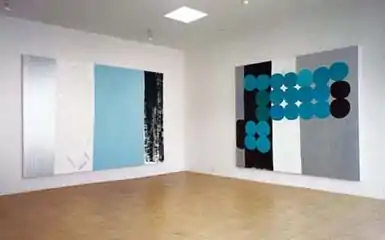
Circular-motif abstraction (1993–2002)
In the early 1990s, Ledgerwood transitioned toward patterned abstraction with directly drawn, sharper-edged circular forms that suggested shimmering light (e.g., Blackness Light, 1992;[43] Rainlight, 1993) and increasingly delved into the experience of perception.[26][4] This work employed monochromatic or limited palettes and dissolving grid arrangements of dots, circles or loops, creating complex, flat plays of oscillating color, tone, surface finish and figure-ground based on light conditions, viewer position and retinal effects;[4][8] critics suggest that this indeterminacy introduces elements of extended time, discovery, and "unknowability" into the viewing experience.[8][44][45] Ledgerwood explored this motif in various color palettes, combining blacks with pinks, purples, magentas and ultramarine (e.g., Tranquilizer, 1997; Basement Love, 1999) in a series exploring sexuality, and yellows on silver and white in another, Op-Art-like series.[44][46][47][48] One of the latter works (the 17' x 35' Groovin' on Lemon, 1995) comprised half of a temporary, site-specific installation commissioned for the new MCA Chicago building, which Ledgerwood described as "a meditation on light and rhythm."[49][11][50] The adjacent, same-sized companion, Groovin' on Violet, fully emerged only after a viewer's eyes adjusted, replicating the afterimage formed from viewing the other work.[49][26]
In 1999, Ledgerwood presented "Cold Days", a body of work specifically created to interact with the changing winter light that would flood its January exhibition at Chicago's Renaissance Society.[51][13] The show's centerpiece was a wall of five, 8' x 9' works painted in subtly modulating lilacs, pastel blues, greens, browns and metallic silvers that functioned as an environment.[4][8] Bearing titles drawn from Miles Davis's Kind of Blue album, the paintings opened to a wide range of allusions, from pop culture, fashion and design to the glamour and effervescence of champagne bubbles to climate (brittle temperatures, the sheen of ice, winter light, whiteouts) and states of contemplation.[4][52][53] Critics compared the work's myriad shifts between obscurity and clarity to those of the Rothko Chapel and Light and Space installations of Robert Irwin.[4] Craig Adcock wrote that the paintings resided "between being and nonbeing, just between the abyss inside and the boundless horizon outside. The operative category is the sublime, shorn of its macho, Kantian implications."[4] In 2002, Ledgerwood created a comparable body of work for exhibition in Los Angeles, titled "Sunny Days" (1301PE, 2002).[1]
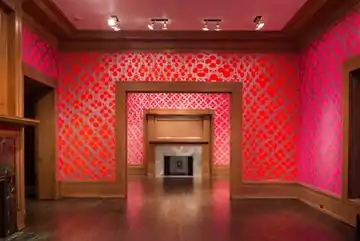
Patterned abstraction and wall paintings (2002– )
Ledgerwood's later work shifted toward repeated vernacular motifs (chevron and diamond, quatrefoil, and floral patterns) and a more confrontational approach embracing discordant color, an integration of painting and drawing, and greater co-optation of architectural space, including that between painting and viewer.[54][55][56][57][58][25] Michelle Grabner suggested this new work laid "bare Ledgerwood's distrust of elegance and finesse" with its contemporary, doodle-like drawing, loose Pop and quilt-like patterns, Matissean flatness, and funky interior-design palettes.[54][59] New York Times critic Ken Johnson described later works in this vein as "paradoxical fusions of actuality and virtuality" painted with "the carefree abandon of an improvising jazz musician."[60] He and others noted Ledgerwood's use of irregular white-bordered edges suggesting drooping, bowed tapestries or quilts pinned to walls (e.g., Grandma's Flower Garden, 2006, above)—a reference to traditionally feminine arts—which combined with her overt decorative forms and de-stabilized grids to upend high-modernist conceits of seriousness.[60][6][25][26]
Other critics, such as John Yau and Roberta Smith, have focused on an anarchic element in the work, which foregrounds imperfection and irregularity, process and messiness, humor and female sexuality, and challenges notions of the sublime and beautiful.[61][6][59][33] Ledgerwood has written that a 2003 health scare prompted a reconsideration and shift in direction in her work, initially signaled—in title and form—in her show, "Ugly Beauty" (2004).[62] Writers suggest that show's off-kilter diamond-patterned grids, unbalanced color interactions, and perspectival shifts posited a modernism reoriented toward fragility and an ungainly, lifelike mortality.[63][59]
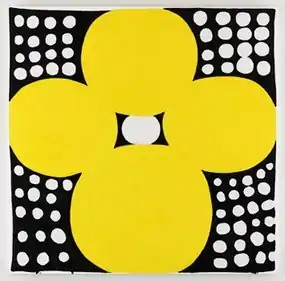
Ledgerwood has frequently extended this work into architectural space, as she did in the public commission Jour et Nuite (Paris Metro RATP Station, 2007) and two solo shows—"Hard Jam" (Tracy Williams Ltd., New York, 2007) and "Chromatic Patterns" (Hausler Contemporary, Zürich, 2008)—that featured monumental paintings and site-specific wall painting installations.[26][33] In the exhibitions, she created progressions of accumulating motifs and bands of color, with single works building to painted environments that assimilated interior architectural elements and replicated being inside a painting.[58][26][33] Ledgerwood created variations on Chromatic Patterns in immense, site-specific installations at the Smart Museum of Art (2013–5),[12] Graham Foundation for Advanced Studies in the Fine Arts (2014)[64] and Art Institute of Chicago (2018).[10][65][25]
In 2010s, Ledgerwood has also increasingly introduced three-dimensional elements into her practice.[6][66] These include a body of smaller, simplified paintings featuring more thickly painted, iconic cruciform arrangements of circles and schematized floral shapes (e.g., Post Punk Female Abstraction, 2010),[6][26] passages of thick, viscous paint squeezed straight out of the tube,[67] relief-like polyurethane "blob paintings,"[66][68] and large, painted ceramic vases.[6]
Collections and recognition
Ledgerwood's work belongs to the public art collections of the Metropolitan Museum of Art,[14] Museum of Contemporary Art, Los Angeles,[15] Art Institute of Chicago,[16] Museum of Contemporary Art Chicago,[17] Kunstmuseum St. Gallen (Switzerland), Hammer Museum,[69] Chicago Public Library, Mary and Leigh Block Museum of Art,[70] Milwaukee Art Museum,[71] and Smart Museum of Art,[72] among others.[73][1] Ledgerwood is a recipient of awards from the Richard H. Driehaus Foundation, Artadia, and Louis Comfort Tiffany foundations, the National Endowment for the Arts, and the Illinois Arts Council.[74][18]
References
- Waspe, Roland, and Philip Vanderhyden. Judy Ledgerwood, Ostfildern, Germany: Hatje Cantz, 2009. Retrieved August 19, 2019.
- Kirshner, Judith Russi. "Conversation with Julia Fish and Judy Ledgerwood," Art in Chicago: A History from the Fire to Now, Ed. Taft, Maggie and Robert Cozzolino, Chicago: The University of Chicago Press, 2018, p. 330–4.
- Yau, John. "Judy Ledgerwood’s Blunt Celebrations of Female Sexuality," Hyperallergic, April 29, 2018. Retrieved August 19, 2019.
- Adcock, Craig. Cold Days: Judy Ledgerwood, Chicago: The Renaissance Society, 1999.
- Snodgrass, Susan. "Review of Exhibitions: Chicago," Art in America, April 1992, p. 166–7.
- Smith, Roberta. "Judy Ledgerwood: 'April Showers'," The New York Times, June 24, 2011, p. C29. Retrieved August 20, 2019.
- Sherlock, Maureen P. "The Land Before Her," Judy Ledgerwood (catalogue), Chicago: Feigen Inc., 1993.
- Walker, Hamza. "Fox in the Snow," Exhibition essay, "Judy Ledgerwood: Cold Days," Chicago: Renaissance Society at the University of Chicago Newsletter, January 1999.
- Yau, John. "Sexual Abstraction: Judy Ledgerwood’s Recent Paintings," The Brooklyn Rail, May 15, 2016. Retrieved August 19, 2019.
- Art Institute of Chicago. "Judy Ledgerwood: Chromatic Patterns for the Art Institute of Chicago," Exhibitions. Retrieved August 20, 2019.
- Museum of Contemporary Art Chicago. "The Wall Projects Series," Exhibition materials, 1996. Retrieved August 20, 2019.
- Smart Museum of Art. "Judy Ledgerwood: Chromatic Patterns for the Smart Museum," Exhibitions. Retrieved August 20, 2019.
- Ledgerwood, Judy. Judy Ledgerwood: Cold Days, Chicago: Renaissance Society at the University of Chicago Newsletter, January 1999.
- Metropolitan Museum of Art. "Copse, 1988, Judy Ledgerwood," Collection. Retrieved August 20, 2019.
- Museum of Contemporary Art, Los Angeles. "Judy Ledgerwood," Fat Track (2001), Collection. Retrieved August 20, 2019.
- Art Institute of Chicago. "Judy Ledgerwood", Artists. Retrieved August 20, 2019.
- Museum of Contemporary Art Chicago. "Judy Ledgerwood", Artists. Retrieved August 20, 2019.
- Grabner, Michelle. ON PTG, Manawa, WI: Poor Farm Press, 2012. Retrieved August 19, 2019.
- Yood, James. "Collaborations 1998: Printworks Gallery," Artforum, February 1999, p. 10.
- Northwestern University. "Judy Ledgerwood, Alice Welsh Skilling Professor of Art" Faculty, Art, Theory and Practice. Retrieved August 20, 2019.
- Renaissance Society. Why Paint?: Judy Ledgerwood, Jim Lutes, Kay Rosen, Kevin Wolff, Chicago: The Renaissance Society at the University of Chicago, 1992.
- Ledgerwood, Judy. "Speakeasy," New Art Examiner, January 1996, p. 14–5.
- Mettam, Laura M. "Artist Insights: Judy Ledgerwood," Chicago Gallery News, May 5, 2015. Retrieved August 20, 2019.
- Barcio, Phillip. "Judy Ledgerwood on Finding Pattern and Decoration in Everyday Life," Hyperallergic, May 17, 2018. Retrieved August 19, 2019.
- Connors, Thomas. "Off the Wall," Modern Luxury, July 1, 2018, pp. 64–8.
- Ghez, Susanne. "Judy Ledgerwood Interview," Judy Ledgerwood, Ostfildern, Germany: Hatje Cantz, 2009. Retrieved August 19, 2019.
- Kirshner, Judith Russi. "Resisting Regionalism," Art in Chicago 1945-1995, Lynne Warren, et al (editors), Museum of Contemporary Art, Chicago, New York: Thames and Hudson, 1996, p. 137. Retrieved May 1, 2018.
- Kirshner, Judith Russi. "Conversation with Kay Rosen and Tony Tasset," Art in Chicago: A History from the Fire to Now, Ed. Taft, Maggie and Robert Cozzolino, Chicago: The University of Chicago Press, 2018, p. 314–9.
- Artner, Alan G. "Catalogue is best part of 'nonspiritual'," Chicago Tribune, June 11, 1987, Sec. 5 p. 11E.
- Hixson, Kathryn. "Chicago in Review," Arts, April 1989, p.108.
- Ghez, Susanne. Cold Days: Judy Ledgerwood, Chicago: The Renaissance Society, 1999.
- Hixson, Kathryn. "Speakeasy," New Art Examiner, January 1996, p. 14–5.
- Waspe, Roland. "The Instant Joy of Painting," Judy Ledgerwood, Ostfildern, Germany: Hatje Cantz, 2009. Retrieved August 19, 2019.
- Pagel, David. "Why Paint?" Why Paint?: Judy Ledgerwood, Jim Lutes, Kay Rosen, Kevin Wolff, Chicago: The Renaissance Society at the University of Chicago, 1992.
- Hixson, Kathryn. "Cool, Conceptual, Controversial," New Art Examiner, May 1988, p. 30–33.
- Art Institute of Chicago. "Summer Fog, 1992, Judy Ledgerwood", Artworks. Retrieved August 20, 2019.
- Rice, Nancy. "'New Realism' Show Is Real, But Not New," St. Louis Post-Dispatch, May 22, 1988. Sec. p. 4C.
- Hixson, Kathryn. "Chicago in Review," Arts, December 1990, p.107-8.
- Kirshner, Judith Russi. "A Narrative of Women’s Experience," Art Criticism, Vol. 6, No. 1, 1990, p. 20–31.
- Artner, Alan G. "Judy Ledgerwood," Chicago Tribune, January 17, 1992, Sec.7, p .66.
- Diehl, Carol. "Judy Ledgerwood/Germans van Eck,” ARTnews, Summer 1993, p.178.
- Bonesteel, Michael. "Medium Cool: New Chicago Abstraction," Art in America, December 1987, p.138–47.
- Art Institute of Chicago. "Blackness Light, 1992, Judy Ledgerwood", Artworks. Retrieved August 20, 2019.
- Yood, James. "Post-hypnotic: University Galleries of Illinois State University," Artforum, April 1999, p. 120.
- Ledgerwood, Judy. In ON PTG, Michelle Grabner (ed,), Manawa, WI: Poor Farm Press, 2012. Retrieved August 19, 2019.
- Byrd, Cathy. "Eye-popping aesthetic: Dots, stripes and squiggles vibrate at ACA and Swan Coach House Galleries," Atlanta Creative Loafing, February 12, 2000, p. 37–38.
- Hawkins, Margaret. "Exhibit shows why Op is on top," Chicago Sun-Times, May 3, 2000, p. 52.
- Horodner, Stuart. "Flat mates," Surface, Summer 2000, p. 72–73.
- Carr, Christopher. "A grand reopening: The new MCA connects art and life," MOSAIC, Northwestern University, Fall 1996, p. 4-5.
- Artner, Alan G. "Bigger not Better," Chicago Tribune, June 30, 1996, Sec 7, p. 12.
- Artner, Alan G. "Judy Ledgerwood’s new works interact with winter light," Chicago Tribune, February 5, 1999, Sec. 7, p. 53.
- Wilk, Deborah. "Judy Ledgerwood," New Art Examiner, April 1999, p. 44–45.
- Walker, Hamza. "The Weeds of Winter," Exhibition materials, "Judy Ledgerwood: Cold Days," Renaissance Society at the University of Chicago Newsletter, 1999.
- Grabner, Michelle. "Judy Ledgerwood," art US, January-February, 2004, p. 18.
- Snodgrass, Susan. "Judy Ledgerwood at Rhona Hoffman Gallery," Art In America, January 2004, p. 110.
- Johnson, Ken. "Judy Ledgerwood: 'Spring Fever'," The New York Times, May 27, 2005, p. E23. Retrieved August 20, 2019.
- Dennis, Suzanne. "A Feast for the Eyes," South China Morning Post, December 28, 2003.
- Fyfe, Joe, "Judy Ledgerwood at Tracy Williams," Art in America, October 2007, p. 216.
- Orden, Abraham. "Circus Without a Tent,” Artnet, February 11, 2005. Retrieved August 20, 2019.
- Johnson, Ken. " Judy Ledgerwood," The New York Times, June 17, 2016. Retrieved August 20, 2019.
- Yau, John. "Judy Ledgerwood 'April Showers': Tracy Williams," The Brooklyn Rail, June 2011, p.52. Retrieved August 19, 2019.
- Ledgerwood, Judy. "Judy Ledgerwood's Top Ten of 2003," Coterie, February 2004.
- 1301PE. "Judy Ledgerwood: Ugly Beauty," Exhibitions. Retrieved August 20, 2019.
- ArtDaily. "Judy Ledgerwood: Chromatic Patterns for the Graham Foundation," ArtDaily, January 2014.
- Zetouni, Sigalit. "Constructing Circles," Chicago Life, December 2013, p. 16.
- Ciezadio, Janina. "Judy Ledgerwood/Rhona Hoffman Gallery," NewCity, January 17, 2011. Retrieved August 19, 2019.
- Dluzen, Robin. "Judy Ledgerwood: Love, Power, Color at Rhona Hoffman Gallery," ART LTD, November, 2013.
- Germanos, Paul. "Anne Wilson & Judy Ledgerwood @ Rhona Hoffman," Chicago Critical, February 5, 2011. Retrieved August 19, 2019.
- Hammer Museum. "Recent Acquisition," Newsletter, Winter 2019. Retrieved August 20, 2019.
- Mary and Leigh Block Museum of Art. "Judy Ledgerwood," Collection. Retrieved August 20, 2019.
- Milwaukee Art Museum. "Judy Ledgerwood," Collection. Retrieved August 20, 2019.
- Smart Museum of Art. "Judy Ledgerwood," Collection. Retrieved August 20, 2019.
- University of Chicago Booth School of Business. "Judy Ledgerwood", Artists. Retrieved August 20, 2019.
- Vogel, Carol. "Visual Artists Win," The New York Times, January 30, 1998. Retrieved August 20, 2019.
External links
- Judy Ledgerwood, Hatje Cantz, Publisher, 2009.
- Judy Ledgerwood, Artist page, Häusler Contemporary, Zürich.
- Judy Ledgerwood, Artist page, Tracy Williams Ltd., New York.
- Judy Ledgerwood, Alice Welsh Skilling Professor of Art, Northwestern University.